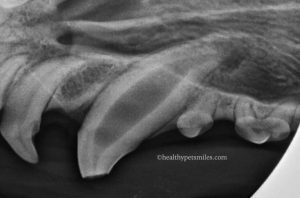Discolored Teeth
In a veterinary practice, it is not uncommon to see discolored teeth in our patients. There are many causes of discoloration, including trauma, infection, metabolic disease, or drug-induced. When evaluating discolored teeth, many things should be taken into consideration including the patient’s age, history, overall health, and how long the tooth/teeth have been discolored. All of these are important factors in determining the cause of the discoloration and the potential treatment options. Discolored teeth are evaluated both visually and radiographically.
Diagnosis:
Diagnosis of discolored teeth is made on visual examination. Visual inspection of a discolored tooth often starts with a procedure called transillumination. A bright light source is directed at the tooth surface/crown. If the pulp of the tooth is alive and healthy, the tooth will glow a pinkish hue. However, if the pulp is non-vital, the crown will glow a dull yellow or grey color and the light will not shine through.
In the above picture, the top canine is dead/non-vital, while the lower canine is alive.
X-rays:
Radiographs are a valuable means of fully evaluating discolored teeth. On x-rays, we are looking at several key elements to see if the tooth shows signs of internal disease (endodontic disease), including the width of the root canal, the health of the bone around the apex of the tooth, and the width and presence of the periodontal ligament. If the root canal is a different width than those of the other teeth around it or if there is evidence of bone loss around the apex of the tooth, these are indicators of endodontic disease, i.e. a “dead” tooth, and treatment should be initiated immediately via root canal therapy or extraction. It is important to note that x-rays are not highly sensitive and will not show signs of early disease, so it is possible that your primary veterinarian or veterinary dentist might recommend treatment even if the x-ray findings are unremarkable.
The upper canine in this x-ray has multiple signs of endodontic disease,
including a wide pulp/root canal, and both periapical and apical lysis.
Treatment:
In previous studies, it has been found that the vast majority of discolored teeth are non-vital, so regardless of visual and radiographic findings, treatment is often recommended for these teeth. The two treatment options available are root canal therapy or extraction, both of which have good long-term success. It is important to discuss these options with your veterinary care provider.
Root canal therapy performed on the non-vital tooth in the picture above.
Consequences of failure to treat non-vital teeth:
Non-vital teeth invariably have a necrotic pulp which serves as a potential nidus for local infection or systemic infection (ex: heart, lung, kidney). Additionally, pathology associated with non-vital teeth can be painful! Have you ever experienced a toothache? These personal experiences can directly affect your attitudes with regard to dental care for your dog or cat. For that reason, although our patients rarely alert us to a painful problem in their mouth, we must remain vigilant and ensure their dental health to prevent infection and pain.










